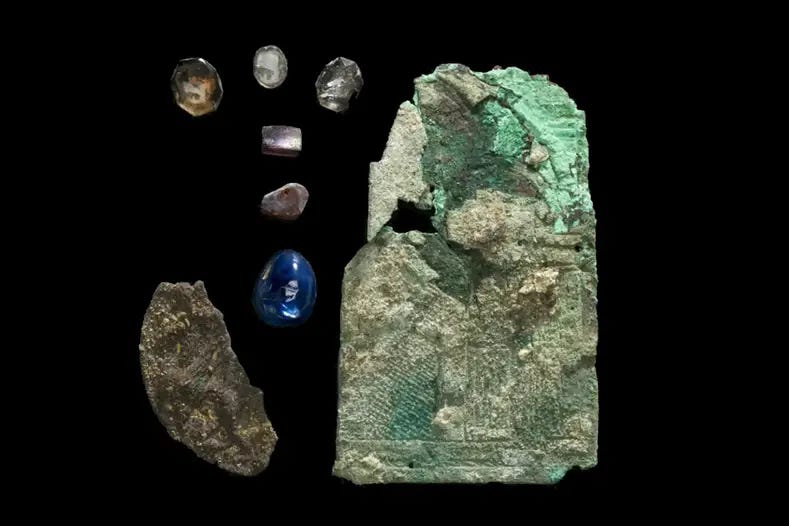🧐 Ancient Beat #111: The purpose of Seahenge, pushing back the settlement of Iran (by 300k years), and more evidence for the Younger Dryas Impact Hypothesis
Hi folks! Welcome to issue #111 of Ancient Beat. Let’s nerd out. Here’s the latest ancient news. 👇
🗞 Ancient News: Top 5
Was Seahenge created for a ritual to extend the summer during climate change battle? — New research into Seahenge, a 4,000-year-old timber circle on Norfolk's Holme-next-the-sea beach, suggests it was built during a period of extreme climatic deterioration around 2049 BCE. The structure features an inverted oak stump surrounded by 55 oak posts, initially constructed on saltmarsh protected from the sea. A second, adjacent ring, Holme II, dated to the same year, centered on two horizontal oak logs. The alignment of Seahenge with the summer solstice sunrise indicates its use in rituals — apparently to extend the summer and return warmer weather. The researchers say that Seahenge's design mirrors folklore about the cuckoo bird, which brought summer with it when it stopped singing and went to the underworld on the summer solstice. According to Alexander Nance, “The monument's form appears to imitate two supposed winter dwellings of the cuckoo remembered in folklore: a hollow tree or 'the bowers of the Otherworld' represented by the upturned oak-stump at its center.” Holme II, oriented towards the sunrise on Samhain, aligns with legends of 'sacred kings' ritually sacrificed to restore harmony. The monuments likely served different but related ritualistic purposes to mitigate the harsh climate.
A Remarkable Discovery of a 450,000-Year-Old Tooth in Iran — Excavations at Qaleh Kurd Cave in Iran's Central Plateau unearthed a human deciduous tooth (AKA a milk tooth), specifically a first upper molar, dating back 452,000 years. This discovery pushes back the known timeline of human settlement in the region by 300,000 years. The site also revealed lithic tools and faunal remains, including evidence of extensive horse butchery, indicating the site's significance for early human subsistence and cultural connections with contemporaneous societies in the Caucasus and the Levant.
Rediscovered: Lost Reliquary of Stavanger's Patron Saint — The lost reliquary of Saint Swithun, the patron saint of Stavanger, Norway, has been rediscovered. This ornate container, dating back to the 12th century, was believed lost for centuries. It was found hidden within a church wall during restoration work. The reliquary, made of wood and adorned with gold and precious stones. Its intricate design includes depictions of saints and biblical scenes, showcasing the artistry and religious devotion of the time. The find is considered one of the most important medieval discoveries in Norway in recent years.
Archaeologists Find at Least 8 More Canoes on Bottom of Lake Mendota, One 4,500 Years Old — Archaeologists have discovered fragments of at least eight more canoes in Lake Mendota, Wisconsin, the oldest dating back 4,500 years. These finds suggest an ancient shoreline storage site and possibly a submerged village. The canoes, ranging from 2,500 BCE to 1,250 CE, highlight shifts in environment and human activity. The oldest canoes were used by nomadic hunter-gatherers, while later canoes indicate the presence of early farming communities.
Study Uncovers New Evidence Supporting Younger Dryas Impact Hypothesis — Recent research has uncovered compelling evidence supporting the Younger Dryas Impact Hypothesis, suggesting a comet or asteroid impact around 12,800 years ago triggered a sudden climatic shift. This event, known as the Younger Dryas, marked a return to glacial conditions after a period of warming. The study identified high levels of platinum and iridium, typically associated with extraterrestrial objects, in sediment layers from various sites in North America and Europe. Additionally, researchers found microspherules and nanodiamonds, both indicative of high-temperature impact events. The impact likely caused widespread wildfires, releasing large amounts of soot and aerosols into the atmosphere, which contributed to the rapid cooling. The Younger Dryas is linked to significant ecological and cultural changes, including megafaunal extinctions and disruptions to human populations. This new evidence strengthens the case for a cosmic impact as a catalyst for one of the most abrupt climatic events in Earth's recent history.
That’s it for the free Top 5! If you’re a free subscriber, sign up for the paid plan for another 18 stories and 5 recommended pieces of content covering ceremonial offerings, burial mounds, migrations, gladiators, advanced medical treatments, mosaics, coin hoards, ostraca, and urbanism.
Until next time, thanks for joining me!
-James
Twitter: @jamesofthedrum
P.S. If you want access but it’s a little too steep for you right now, just email me — I want this to be accessible.
P.P.S. Paid members, read on!
🗞 Ancient News: Deep Dive
Keep reading with a 7-day free trial
Subscribe to Ancient Beat to keep reading this post and get 7 days of free access to the full post archives.


